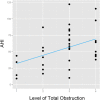Dynamic Drug-Induced Sleep Computed Tomography in Adults With Obstructive Sleep Apnea
- PMID: 27762308
- PMCID: PMC5071907
- DOI: 10.1038/srep35849
Dynamic Drug-Induced Sleep Computed Tomography in Adults With Obstructive Sleep Apnea
Abstract
Surgical success for obstructive sleep apnea (OSA) depends on identifying sites of obstruction in the upper airway. In this study, we investigated sites of obstruction by evaluating dynamic changes in the upper airway using drug-induced sleep computed tomography (DI-SCT) in patients with OSA. Thirty-five adult patients with OSA were prospectively enrolled. Sleep was induced with propofol under light sedation (bispectral index 70-75), and low-dose 320-detector row CT was performed for 10 seconds over a span of 2-3 respiratory cycles with supporting a continuous positive airway pressure model. Most (89%) of the patients had multi-level obstructions. Total obstruction most commonly occurred in the velum (86%), followed by the tongue (57%), oropharyngeal lateral wall (49%), and epiglottis (26%). There were two types of anterior-posterior obstruction of the soft palate, uvular (94%) and velar (6%), and three types of tongue obstruction, upper (30%), lower (37%), and upper plus lower obstruction (33%). DI-SCT is a fast and safe tool to identify simulated sleep airway obstruction in patients with OSA. It provides data on dynamic airway movement in the sagittal view which can be used to differentiate palate and tongue obstructions, and this can be helpful when planning surgery for patients with OSA.
Figures





Similar articles
-
Drug-Induced Sleep Computed Tomography-Directed Upper Airway Surgery for Obstructive Sleep Apnea: A Pilot Study.Otolaryngol Head Neck Surg. 2019 Jan;160(1):172-181. doi: 10.1177/0194599818800288. Epub 2018 Sep 18. Otolaryngol Head Neck Surg. 2019. PMID: 30226110
-
Drug-induced sleep endoscopy for upper airway evaluation in children with obstructive sleep apnea.Laryngoscope. 2013 Jan;123(1):292-7. doi: 10.1002/lary.23832. Epub 2012 Nov 20. Laryngoscope. 2013. PMID: 23168682
-
Effects of mandibular advancement on upper airway dimension and collapsibility in patients with obstructive sleep apnea using dynamic upper airway imaging during sleep.Oral Surg Oral Med Oral Pathol Oral Radiol Endod. 2010 May;109(5):712-9. doi: 10.1016/j.tripleo.2009.11.034. Epub 2010 Mar 29. Oral Surg Oral Med Oral Pathol Oral Radiol Endod. 2010. PMID: 20303302
-
Interobserver Consistency of Drug-Induced Sleep Endoscopy in Diagnosing Obstructive Sleep Apnea Using a VOTE Classification System.J Craniofac Surg. 2018 Mar;29(2):e140-e143. doi: 10.1097/SCS.0000000000003876. J Craniofac Surg. 2018. PMID: 28906336 Review.
-
Diagnostic studies in obstructive sleep apnea.Otolaryngol Clin North Am. 2007 Aug;40(4):785-805. doi: 10.1016/j.otc.2007.04.005. Otolaryngol Clin North Am. 2007. PMID: 17606023 Review.
Cited by
-
Ramped versus sniffing position in the videolaryngoscopy-guided tracheal intubation of morbidly obese patients: a prospective randomized study.Korean J Anesthesiol. 2023 Feb;76(1):47-55. doi: 10.4097/kja.22268. Epub 2022 Aug 1. Korean J Anesthesiol. 2023. PMID: 35912427 Free PMC article. Clinical Trial.
-
Post-Operative Sleep Endoscopy with Target-Controlled Infusion After Palatopharyngoplasty for Obstructive Sleep Apnea: Anatomical and Polysomnographic Outcomes.Nat Sci Sleep. 2021 Jul 20;13:1181-1193. doi: 10.2147/NSS.S311702. eCollection 2021. Nat Sci Sleep. 2021. PMID: 34321943 Free PMC article.
-
Characteristics and Mechanism of Upper Airway Collapse Revealed by Dynamic MRI During Natural Sleep in Patients with Severe Obstructive Sleep Apnea.Nat Sci Sleep. 2023 Nov 1;15:885-902. doi: 10.2147/NSS.S423303. eCollection 2023. Nat Sci Sleep. 2023. PMID: 37933249 Free PMC article.
-
Airflow Shape Is Associated With the Pharyngeal Structure Causing OSA.Chest. 2017 Sep;152(3):537-546. doi: 10.1016/j.chest.2017.06.017. Epub 2017 Jun 23. Chest. 2017. PMID: 28651794 Free PMC article.
-
Dynamic sleep MRI in obstructive sleep apnea: a systematic review and meta-analysis.Eur Arch Otorhinolaryngol. 2022 Feb;279(2):595-607. doi: 10.1007/s00405-021-06942-y. Epub 2021 Jul 9. Eur Arch Otorhinolaryngol. 2022. PMID: 34241671 Free PMC article.
References
-
- Strollo P. J. Jr. & Rogers R. M. Obstructive sleep apnea. N. Engl. J. Med. 334, 99–104 (1996). - PubMed
-
- Peppard P. E. et al.. Prospective study of the association between sleep-disordered breathing and hypertension. N. Engl. J. Med. 342, 1378–1384 (2000). - PubMed
-
- Yaggi H. K. et al.. Obstructive sleep apnea as a risk factor for stroke and death. N. Engl. J. Med. 353, 2034–2041 (2005). - PubMed
-
- Kushida C. et al.. American Academy of Sleep Medicine. Practice parameters for the use of continuous and bilevel positive airway pressure devices to treat adult patients with sleep-related breathing disorders. Sleep. 29, 375–380 (2006). - PubMed
-
- Chen N. H. et al.. Airway assessment by volumetric computed tomography in snorers and subjects with obstructive sleep apnea in a Far-East Asian population (Chinese). Laryngoscope. 112, 721–726 (2002). - PubMed
Publication types
MeSH terms
Substances
LinkOut - more resources
Full Text Sources
Other Literature Sources
Medical

